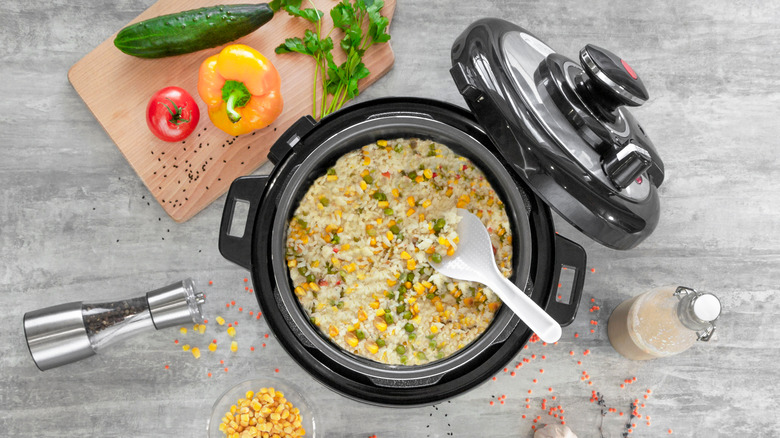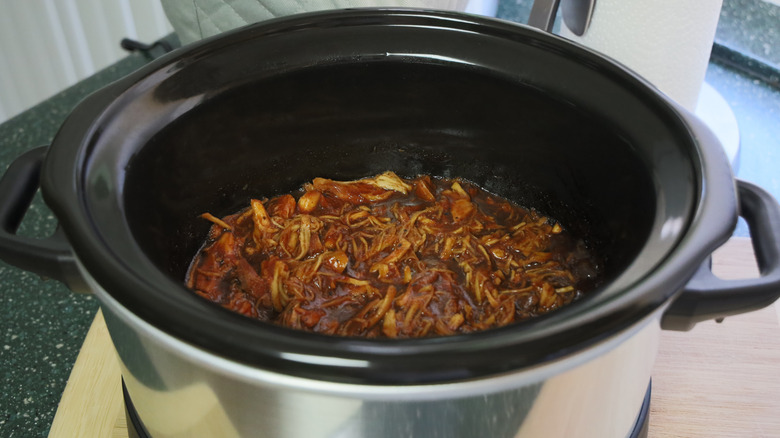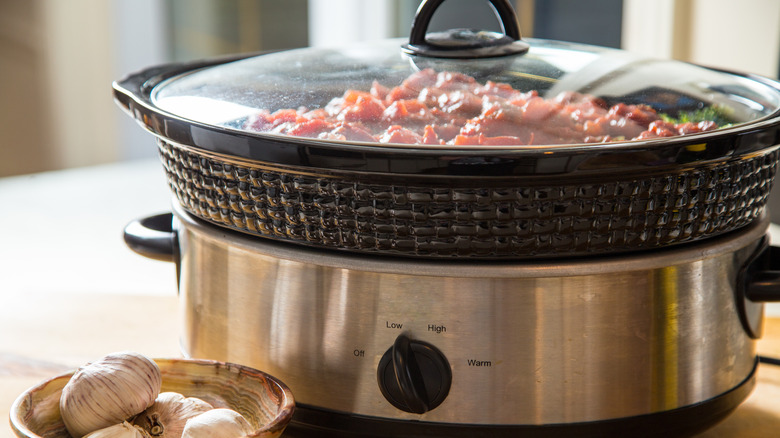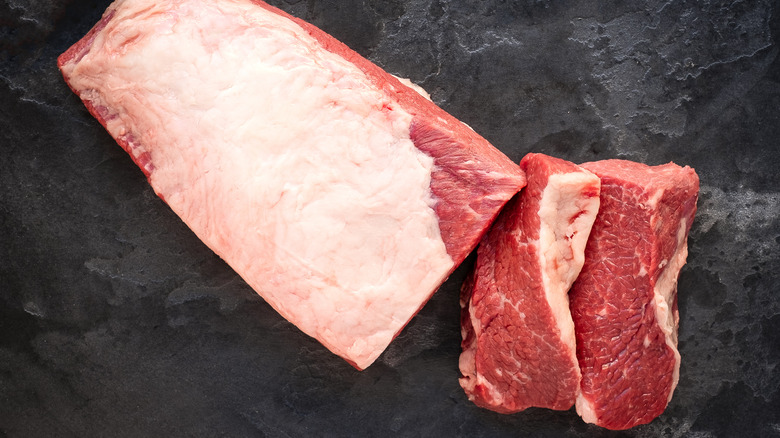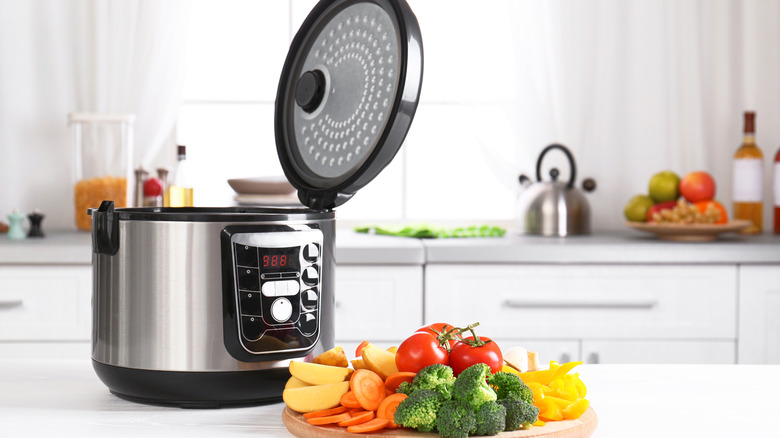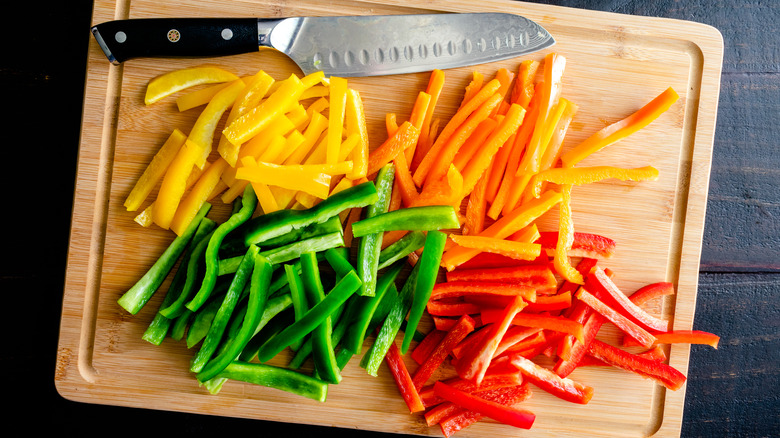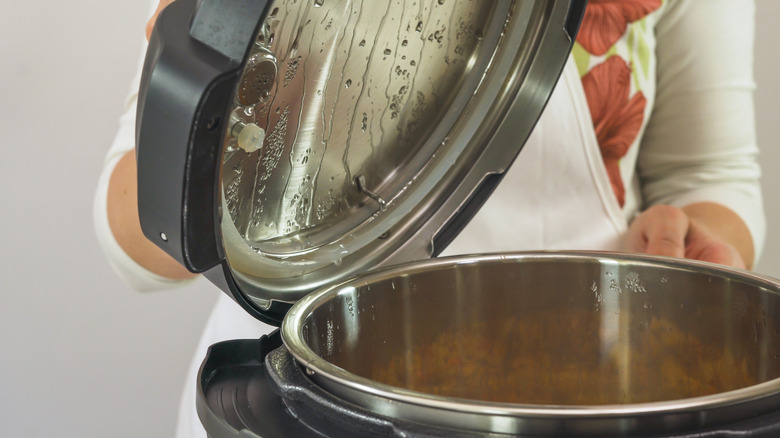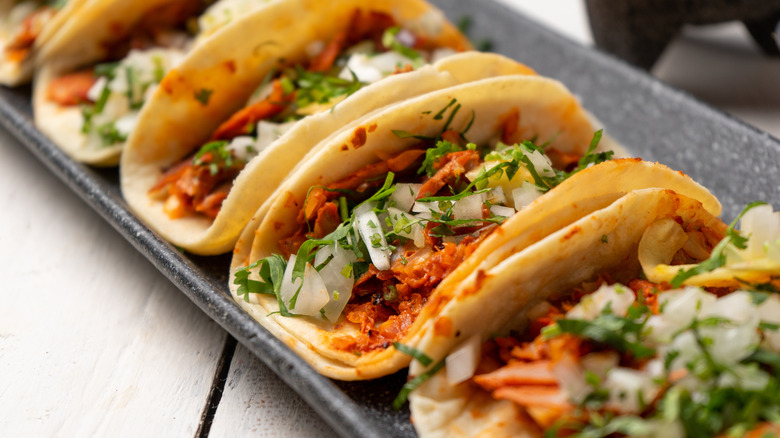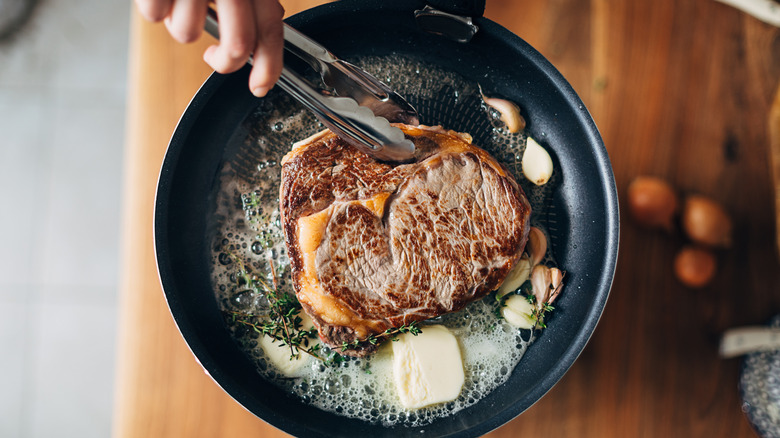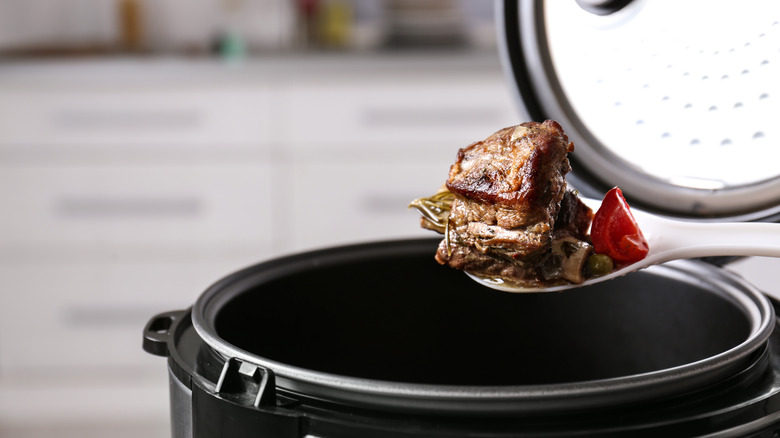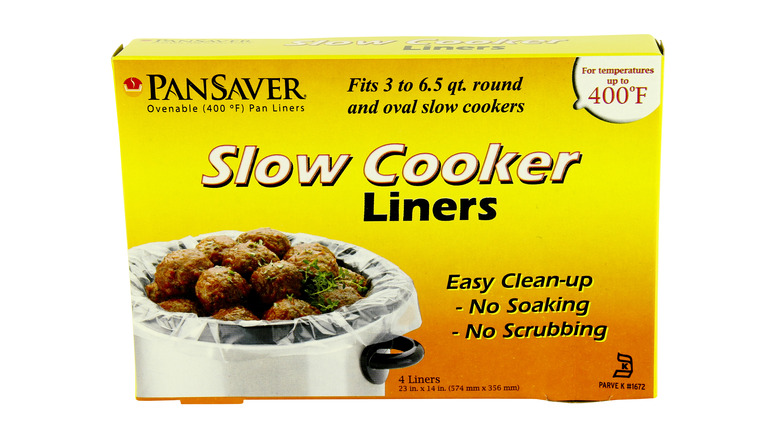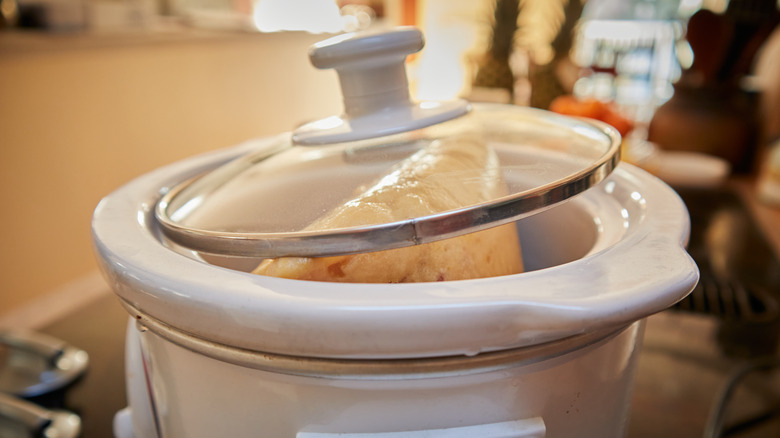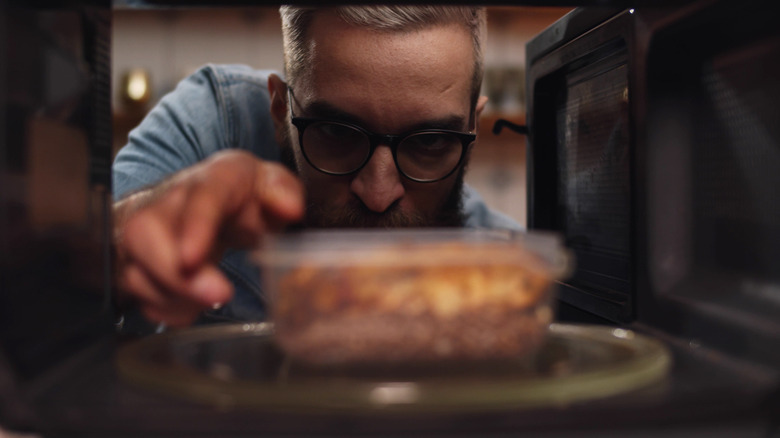Tips You Need When Cooking With A Slow Cooker
Air fryers may be one of the most of-the-moment kitchen appliances, but that doesn't mean we should forget all the trendy appliances that came before it. One of our absolute favorites is the multi-purpose slow cooker. Just like air fryers, slow cookers allow you to cut down on the time you spend in the kitchen while still ensuring your food tastes as good as possible. They're great for busy families or singles, and they can be used to make a wide array of healthy meals. Who doesn't love a kitchen appliance that does so much right?
But if you don't know how to properly utilize your slow cooker, you may be left with mushy food, overcooked dishes, or even a big mess on your hands, and that's enough to make you never want to use your slow cooker again. But don't worry — we've compiled some of the best slow cooker tips out there so you can whip up whatever dish you're dreaming of with the least fuss possible. These tips will have you using your slow cooker for new and old recipes alike.
Choose the right size
Before you even buy a slow cooker, you're going to want to make sure you're getting one that works for the particular recipes you want to tackle. It can be easy to just buy a slow cooker off the shelf or off the internet that doesn't really give you what you need. Therefore, it pays to be thoughtful at this step. First, think about how many people you have in your household. Are you going to be cooking for a family of six, or are you generally just cooking for yourself? This will give you your first hint about what size slow cooker you should be picking up (per The Kitchn).
Don't stop there, though. If you live alone, you may think that a small slow cooker is the way to go. But think about what you plan on using yours for. If you're hoping to cut down on cook time by making a big batch of food at the beginning of the week, it may still make sense to invest in a larger slow cooker so you can meal prep to your heart's content. Also, consider how much counter space you have. For those living in big cities that tend to have smaller kitchens, a large slow cooker can simply take up more room than it's worth.
Opt for a programmable slow cooker
Just like slow cookers come in all shapes and sizes, they also come with varying functions (per Consumer Reports). Some styles of slow cookers require you to manually adjust your cook settings. This means that you have to set the temperature and adjust it when you're ready to cut or increase the heat or time. These are fine to use if you're home all day and don't tend to leave your home while your slow cooker is on.
However, if you want something that's going to be a little more hands-off, Consumer Reports writes that it can pay to look for a programmable slow cooker. Many brands offer slow cookers that have this feature; basically, you can program the cooker to heat your food at a certain temperature for a specified amount of time. Then, when that time has elapsed, the slow cooker will simply keep your food warm until you have the chance to eat and turn it off. This is helpful if you usually use your slow cooker during busy days when you don't always have time to be in the kitchen.
Again, think about what you need out of your slow cooker before you make a big purchase, and there's a better chance you'll be happier with whatever product you choose.
Don't forget to preheat your slow cooker
You know you have to preheat your oven when you're baking or roasting a dish, and you're aware that preheating your pan is important before you start searing a piece of meat. But did you know that slow cookers also require preheating in many cases? It turns out that, according to The Kitchn, you build the most flavor in your dish in just the first few minutes of cooking. And while slow cooker recipes often call for you to sauté veggies or aromatics before they ever go in the slow cooker, putting those hot ingredients into a cold slow cooker can really keep those flavors from developing nicely.
In comments to The Kitchn, chef and cookbook author Neela Paniz says that adding your sautéed aromatics to a preheated slow cooker can ensure you lock in as much of that extra flavor as possible. Plus, the University of Minnesota Extension says that cooking your food on the hottest setting for the first hour can cut down on food safety issues that could cause health problems. Does this extra step take some extra time? Yes. But in most cases, we think it's worth it.
Look for cheaper, tougher cuts of meat
Are you planning on cooking meat in your slow cooker? If so, you may be wondering which cuts you should be choosing when you're at the grocery store. While your slow cooker can handle a variety of different types of meat, you're probably going to want to go for inexpensive cuts. That's because that type of meat is often tricky to cook in other ways, while it can turn nice and tender when cooked in a slow cooker (per The Steak School).
Choice suggests using cuts like chuck steak, ham hocks, and bottom rounds. These tough cuts of meat are some of the most affordable you'll find in the meat section at your grocery store, and they can be transformed into wonderfully delicious dishes when they're cooked low and slow for several hours at a time. If you're looking for a way to cut your grocery budget while still getting plenty of protein into your diet, this is a great way to go about it.
Use the low setting if you'll be away from home
If you've ever read a slow cooker cookbook before, then you may have noticed that there will be different cook times listed whether you decide to cook your food on the high or low setting. Most of the time, we tend to think that if it's done faster, that's better. But if you get home at 5 p.m. and throw your food in the slow cooker immediately, you're still not going to start eating until at least 9 p.m. That's why it may not be a bad idea to choose the low setting instead.
When you cook on the low setting, you'll often leave your food in the slow cooker for eight hours at a time (per Delish). That can seem like a long time, but if you start cooking early in the morning before you leave for work, by the time you get home, your dinner will be made and ready to eat immediately. Plus, there are other benefits to cooking your food more slowly. According to The Spruce Eats, cooking low and slow gives your ingredients more time to take on those delicious flavors that make every bite taste fantastic.
Prep your ingredients the night before
For those who do plan on keeping their slow cookers on all day, the mornings can be a mad scramble to get everything done. Not only do you have to get up and get ready for work, but you also have to prep a whole meal? That kind of morning schedule can seem overwhelming to some. If you're looking to save time in the mornings, your best bet is to prep all your ingredients the night before. By chopping up your veggies and prepping your meat ahead of time, you can just throw everything in your slow cooker and be on your way in the morning.
If you want to save even more time, you can prep all your veggies at the beginning of the week. Head to the grocery store on a Sunday (or whenever you have a day off), and wash and chop everything then. Place it in containers, and then you won't even have to think about prepping anything for a whole week — or at least a few days. It's one of our favorite ways to ensure we always have fresh, healthy food to eat.
Limit how much you check on your food
Slow cooking is a notoriously easy way to throw a meal together, but that doesn't mean that it's impossible to make mistakes. However, most mistakes that people make with slow cookers come down to doing too much instead of not doing enough. Perhaps the chief slow cooker mistake you can make involves just that: continually checking on your food by lifting the lid and looking, tasting, or just admiring your work.
The Kitchn says that while you may be tempted to lift the lid of your slow cooker to see how your meal is coming along, that's generally a pretty bad idea. That's because slow cookers function by trapping heat in the machine, which is what cooks your food. If you keep lifting the lid, you're letting all that heat escape. And if you do this too often, your food is going to take a lot longer to cook. Sure, if you have to do it once or twice very quickly during the cooking process, you may not add too much cook time. But keep doing it, and you may add hours of cook time to your process. Clearly, that should be avoided, especially if you're using your slow cooker to cut down on the amount of time you spend in the kitchen.
Put your food in the slow cooker, and just let it do its thing. Your dish will be done before you know it if you just leave it alone.
Don't just settle for stews
When you think of slow cooker food, what first comes to mind? If you're like a lot of people, you immediately think of stews. Of course, you can make a wide range of delicious stews in your slow cooker with very little effort. But that doesn't mean you can only make stews in your slow cooker. If that's all you're sticking to then you're cheating yourself out of all the possibilities a slow cooker truly affords.
For example, why not try making some tacos al pastor? Alternatively, you could make a slow cooker pork loin roast or Crockpot sesame chicken. And of course, you can't forget about barbecue brisket and carnitas. Don't let this list limit you, either. What we're getting at is that you have a lot of options, and you should explore all of them if you have a slow cooker at home. Of course, that doesn't mean you should stop making stews either — there's room for as many different dishes as you want to make in your slow cooker.
Sear your meat before placing it in the slow cooker
If you know anything about cooking meat, you know that searing is all the difference when it comes to concentrating flavors in a dish and making them taste as good as possible. However, you may think that when you're using a slow cooker, searing meat is out of the question. But, that assumption couldn't be further from the truth. In fact, according to AllRecipes searing is actually super important when you're cooking your meat in a slow cooker.
As AllRecipes suggests, it's so important to sear because it helps the meat develop more complex flavors as it cooks. Even if you're not cooking a huge hunk of meat and you're opting for ground meat instead, browning is still essential. It ensures that the meat doesn't get all clumpy in your finished dish and prevents too much fat from piling up in your slow cooker and making your dish too rich. While yes, this extra step does add some cooking time to your recipe, we totally think it's worth it to infuse your dish with more flavor.
Make sure you're not overcooking your food
Because you leave your food in your slow cooker for such a long time, you may assume that it can't ever be overcooked. But we're here to break the news that your assumption is far from the truth. In reality, it's quite easy to overcook food in a slow cooker, and it'll taste just as dry and unappetizing as it would if you overcooked it using any other method (via Livestrong). Cook for too long and meat is liable to become dry and tough, and veggies can turn into slimy lumps of indistinguishable mush.
Therefore, overcooking is something you'll want to avoid when using your slow cooker. Your best bet is to follow the time listed on your recipe closely. Also, make sure you're cooking on the right setting. If a recipe calls for cooking for eight hours on low heat, you're likely to overcook the dish if you go for eight hours on high heat. Double-checking your recipe directions before you turn on the slow cooker is never a bad idea.
Use slow cooker liners for faster cleanup
Let's be honest: Cooking, in general, can be a messy endeavor. If you feel like you're always cleaning your kitchen, you know exactly what we're talking about. And even though a slow cooker generally produces less of a mess than other forms of cooking like roasting or frying, that doesn't mean it doesn't take some time and energy to clean out your slow cooker. For those who want to avoid that extra time and energy, slow cooker liners are a dream come true.
These clear plastic liners can be found at most grocery stores and online, and they provide a barrier to place between the slow cooker and your food. Per FAQs from the slow cooker brand Crock-Pot, proper liners are safe to use with heat, so you should make sure you're getting actual slow cooker liners because not every type of plastic will work here. Of course, not everyone wants to create more plastic waste, but on those nights when you just can't be bothered to clean, slow cooker liners are a reasonable option.
Take the veggies out if they're cooking too quickly
We already talked about the dangers of overcooking your food in a slow cooker. But what if your veggies are overcooking but your meat still has hours left to go? This isn't always an easy problem to solve, especially if you're dealing with small veggies like peas (which you generally shouldn't add to the cooker until the last minute anyway). But most of the time, when you're cooking both veggies and meat at the same time, it's totally okay to remove the veggies that are overcooked to prevent them from getting too mushy.
Just take a slotted spoon and remove the broccoli, carrots, peppers, or whatever else is in your slow cooker that has already been thoroughly cooked. Set them aside until the meat is finished cooking through, and then add them back to your slow cooker just before you get ready to serve. This can prevent you from dealing with mushy, unappealing veggies in your dish.
Give flavors time to meld in your dishes
Most of the time, you're going to want to make sure that whatever you're eating is as fresh as possible. But when it comes to many foods that you cook in a slow cooker, it might actually make more sense to prepare your dish one day and then eat it the next. Why? According to Eat This, Not That!, you can actually enhance the flavor of your food by letting it sit overnight. Of course, you don't want to leave it out on the counter — we're talking about leaving it in the fridge.
This is because chemical reactions can occur even after the food is finished cooking. These reactions can enhance the flavors of your food, allowing the different ingredients to mix and meld together even better.
That doesn't mean you have to leave every dish until the next day before you eat it, but it does mean that you should consider making bigger batches and saving the leftovers for the next day. Your future self is sure to thank you.
